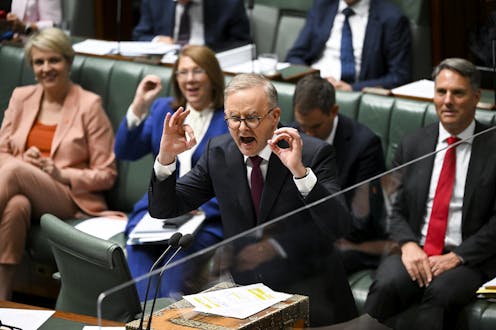Source: The Conversation (Au and NZ) – By Adrian Beaumont, Election Analyst (Psephologist) at The Conversation; and Honorary Associate, School of Mathematics and Statistics, The University of Melbourne

Lukas Coch/AAP
A federal Resolve poll for Nine newspapers, conducted November 30 to December 4 from a sample of 1,611, gave Labor 42% of the primary vote (up three since the post-budget Resolve poll in late October), the Coalition 30% (down two), the Greens 11% (down two), One Nation 4% (steady), the UAP 2% (up one), independents 8% (steady) and others 3% (steady).
Resolve does not provide a two-party estimate until shortly before elections, but applying 2022 election preference flows to these primary votes gives Labor about a 60-40 lead, a two-point gain for Labor.
On Prime Minister Anthony Albanese, 60% thought he was doing a good job and 24% a poor job, for a net approval of +36, up seven points. Opposition Leader Peter Dutton’s net approval was down two points to -14. Albanese led as preferred PM by 54-19 (53-19 previously).
On voting intentions, this is Labor’s best result in any poll since the August Resolve poll (an estimated 61-39 to Labor). Albanese’s net approval is back to where it was in August, while Dutton’s is the worst of any Resolve poll since he became opposition leader.
In polls conducted since the May election, Resolve has been skewing left, with Newspoll, Essential and especially Morgan giving Labor far more modest leads.
Read more:
Labor retains big lead in Newspoll as Albanese’s ratings jump; Victorian election update
Labor led the Liberals by 38-31 as party best for economic management (38-32 previously). On keeping the cost of living low, Labor led by 37-24 (31-24 previously).
By 79-4, voters supported setting price caps that utility companies cannot go over to tackle power prices. This was easily the most popular option, with 70-3 support for reserving a portion of gas for export to the local market and 63-6 support for bringing back or retaining ownership of power assets in public hands.
Morgan poll: 54.5-45.5 to Labor
After slipping to a lead of just 52.5-47.5 last week, this week Labor’s lead in Morgan’s weekly federal poll has rebounded to 54.5-45.5. Polling was conducted November 28 to December 4.
Victorian election update: Labor wins Northcote and Preston
After distribution of preferences, Labor has officially won Northcote by a 50.2-49.8 margin over the Greens. In Preston, there was speculation that an independent could win from fourth by overtaking the Greens then beating Labor, but preferences from minor candidates did not assist the independent, with Labor defeating the Greens.
The ABC now gives Labor 54 of the 88 lower house seats, the Coalition 27, the Greens four and three still to be decided. The distribution of preferences will likely settle Bass (Labor leads 50.3-49.7 over Liberals) and Pakenham (Liberals lead 50.1-49.9 over Labor). Narracan will likely be won by the Coalition when the deferred election is held.
In the upper house, the ABC’s calculator applied to all eight regions currently gives Labor 15 of the 40 seats, the Coalition 14, Legalise Cannabis three, the Greens two, and one each for Animal Justice, Transport Matters, the Liberal Democrats, the Shooters, Labour DLP and One Nation.
On Monday I wrote that Transport Matters is very unlikely to win once below the line votes are factored in, with that seat going to the Greens instead. So the overall upper house is still likely to be 22 left to 18 right, with Labor needing the Greens and Legalise Cannabis to pass legislation opposed by the right.
Read more:
Labor, Greens and Legalise Cannabis likely to have combined majority in Victorian upper house
All eight upper house regions are now at at least 70% of enrolled voters counted. The final turnout for the lower house was 87.1%. I expect final results for the upper house next week.
US Democrats to have 51-49 Senate majority after winning Georgia runoff
On Tuesday (Wednesday AEDT), Democrat Raphael Warnock defeated Republican Herschel Walker by a 51.4-48.6 margin in the Georgia Senate runoff. The runoff occurred after neither Warnock nor Walker won a majority on November 8. I covered the runoff for The Poll Bludger.
This result gives Democrats (including two independents who caucus with them) a 51-49 United States Senate majority, a gain of one seat for Democrats for the 2022 midterm elections. The one state that changed party control at these elections was Pennsylvania, a Democratic gain.
While holding the Senate with an increased majority is good for Democrats, only one-third of Senate seats are up for election every two years. In 2024, the seats that are up will be far more difficult for Democrats, as they will be defending 23 seats to just ten Republican defences. Three Democrats will be defending states Donald Trump won easily in both 2016 and 2020 – West Virginia, Montana and Ohio.
Republicans won the House of Representatives by a 222-213 majority at the midterms, a reversal of Democrats’ 222-213 majority after the 2020 elections. Unlike the Senate, all 435 House seats are up every two years.
Legislation needs to be approved by both chambers of Congress, so Democrats won’t be able to pass partisan legislation once the new Congress is sworn in on January 3. But the Senate alone can confirm presidential nominations for judges and cabinet-level appointments. So President Joe Biden’s judicial nominations will be confirmed for the next two years.
![]()
Adrian Beaumont does not work for, consult, own shares in or receive funding from any company or organisation that would benefit from this article, and has disclosed no relevant affiliations beyond their academic appointment.
– ref. Resolve poll gives Labor huge lead; US Democrats win Georgia Senate runoff – https://theconversation.com/resolve-poll-gives-labor-huge-lead-us-democrats-win-georgia-senate-runoff-196047








